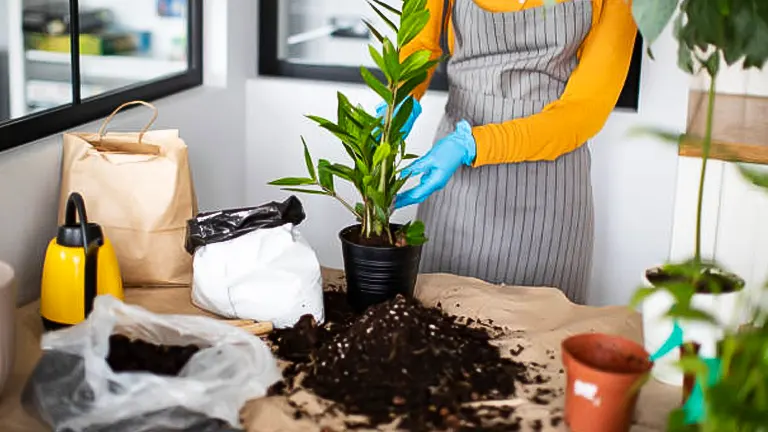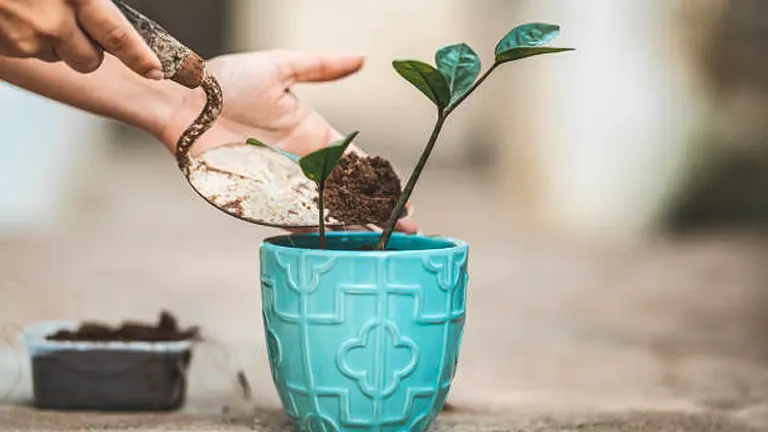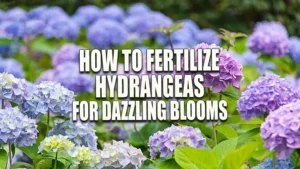How to Fertilize Indoor Plants: Boost Your Houseplants’ Growth and Beauty
- April 19, 2024
- 0 comment
Learn how to fertilize your indoor plants effectively! Boost growth and beauty with our easy tips. Ensure your houseplants thrive. Start now! Are you dreaming of nurturing houseplants that not only grow robustly but also enhance the beauty of your indoor space? Mastering the art of fertilization is key. This comprehensive guide will unveil essential steps and best practices to feed your plants, tailored for both seasoned gardeners and beginners.

Discover actionable tips to help your indoor garden thrive and transform your living area into a vibrant, inviting oasis. Dive into the secrets of effective plant fertilization and watch as your houseplants flourish, bringing life and color to your home all year round.
Table of Contents
- Understanding Plant Nutrition
- Choosing the Right Fertilizer
- Fertilization Needs by Plant Type
- The Fertilization Process
- Best Practices for Fertilizer Application
- Adjusting Fertilization for Seasons and Plant Life Stages
- Conclusion
- FAQs
Understanding Plant Nutrition of Indoor Plants

Proper nutrition is crucial for the health and beauty of indoor plants. Plants require a variety of nutrients, which are broadly classified into macronutrients and micronutrients. Here’s a deeper look at these essential elements, their roles, optimal levels, and signs of deficiencies.
Macronutrients
Macronutrients are required in larger quantities as they form the foundation of plant growth and development:
- Nitrogen (N): Vital for the synthesis of proteins and chlorophyll, nitrogen is a key component of amino acids, the building blocks of plant tissue. It predominantly affects leaf and stem growth.
- Phosphorus (P): Essential for the transfer of energy within the plant for processes such as photosynthesis and nutrient uptake. It plays a significant role in the formation of DNA, RNA, and ATP, facilitating root development and blooming.
- Potassium (K): Potassium regulates the opening and closing of stomata, thereby managing water use. It is also crucial for activating enzymes and forming sugars and starches.
Micronutrients
Micronutrients, though needed in smaller amounts, are critical for preventing disease and enabling the plant to complete its life cycle:
- Iron, Manganese, Zinc, and Copper are primarily involved in chlorophyll production and the photosynthesis process.
- Molybdenum and Boron are essential for the reproductive success of the plant, including seed and fruit development.
- Chlorine is necessary for osmoregulation and stabilization of cell turgor pressure.
Nutrient Availability and Optimal Concentrations
The following table details the essential nutrients, their primary functions, visible deficiency symptoms, and their optimal soil concentrations for indoor plants:
| Nutrient | Primary Function | Deficiency Symptoms | Optimal Soil Concentration (mg/kg) |
|---|---|---|---|
| Nitrogen (N) | Protein/chlorophyll synthesis, leaf growth | Yellowing leaves, stunted growth | 15-50 |
| Phosphorus (P) | Energy transfer, root/flower development | Dark, blue-green foliage, delayed growth | 10-30 |
| Potassium (K) | Stomata regulation, enzyme activation | Scorching at leaf edges, curling tips | 20-50 |
| Iron (Fe) | Chlorophyll formation, electron transport | Chlorosis, poor growth | 0.5-10 |
| Manganese (Mn) | Enzyme activation, chlorophyll production | Chlorosis between veins, spotted leaves | 0.5-10 |
| Zinc (Zn) | Auxin synthesis, chlorophyll production | Stunted growth, pale foliage | 0.5-10 |
| Copper (Cu) | Respiration, electron transport | Dieback, bluish leaves | 0.5-10 |
| Molybdenum (Mo) | Nitrate reduction, protein synthesis | Cupping and rolling of leaves | 0.01-0.5 |
| Boron (B) | Cell wall formation, reproductive growth | Tip burn, hollow stems | 0.5-10 |
| Chlorine (Cl) | Osmotic adjustment, ionic balance | Wilting, chlorosis | 5-100 |
The Role of Soil pH in Nutrient Absorption
Soil pH significantly influences the solubility of nutrients, affecting their availability to plants. Most houseplants thrive in slightly acidic to neutral soils (pH 6.0 to 7.0), which optimizes the availability of most macronutrients and micronutrients.
- Acidic Soils (pH < 6.0): Increase the solubility of micronutrients like iron and manganese, which can be beneficial up to a point but may lead to toxicity if the pH is too low.
- Alkaline Soils (pH > 7.0): May cause phosphorus, iron, and manganese to precipitate, making them unavailable to plants, which can result in deficiency symptoms.
Adjusting soil pH with lime (to raise pH) or sulfur (to lower pH) can help maintain the optimal nutrient availability. Regular pH testing and adjustments ensure that your plants receive the maximum benefit from the nutrients present in their soil.
Choosing the Right Fertilizer

Selecting the appropriate fertilizer is crucial for promoting healthy, vibrant growth. The type of fertilizer you choose should be carefully matched to the specific needs of your plants and the conditions of your indoor environment.
Types of Fertilizers
Fertilizers can be broadly categorized into synthetic and organic types, each with different properties and benefits for indoor gardening:
- Synthetic Fertilizers:
- Quick-Release Formulas: These fertilizers are water-soluble and provide immediate nutrient availability to plants, which is ideal for correcting deficiencies quickly. However, they can lead to salt buildup in the soil, which might harm plant roots and microorganisms.
- Controlled-Release Formulas: Encapsulated nutrients are released slowly over time, reducing the risk of salt buildup and providing a steady supply of nutrients, which is less likely to cause root burn.
- Organic Fertilizers:
- Composition: Made from natural materials such as compost, manure, or bone meal, these fertilizers improve soil structure, enhance soil fertility over time, and help establish a healthy microbiome.
- Nutrient Release: They break down slowly under the action of soil microbes, providing a gradual, more natural nutrient supply which promotes healthier plant growth without sudden spikes.
Forms of Fertilizers
The physical form of the fertilizer also affects its application and effectiveness:
- Liquid Fertilizers:
- Advantages: Easy to apply, allowing for precise control over dosage. Nutrients are distributed uniformly and are immediately available to plants.
- Application: Best applied at watering time, absorbed both through roots and foliage, providing quick nourishment.
- Granular Fertilizers:
- Advantages: Typically slow-release, helping in gradually nourishing the plant and maintaining long-term soil health.
- Application: Applied to the soil surface and watered in, ideal for extended nutrition especially in potting mixes that retain nutrients.
- Fertilizer Spikes:
- Advantages: Driven into the soil to dissolve slowly, spikes provide a continuous supply of nutrients with minimal effort.
- Limitations: They can be less precise in nutrient distribution and may not be ideal for plants requiring more specific feeding schedules.
Understanding NPK Ratios
The NPK ratio on a fertilizer label indicates the levels of Nitrogen (N), Phosphorus (P), and Potassium (K), which are critical for plant health:
- High-Nitrogen Fertilizers (24-8-16): Best for promoting foliage growth in plants like leafy greens and grasses.
- Balanced Fertilizers (10-10-10): Suitable for a wide range of houseplants, promoting overall health, supporting both leaf and root development, and aiding in flowering and fruiting.
- High-Phosphorus Fertilizers (10-20-10): Ideal for flowering plants that benefit from extra root and bloom support.
Specialized Plant Fertilizers
Some plants have very specific nutritional needs that generic fertilizers cannot meet:
- Fertilizers for Acid-Loving Plants: These typically have a higher proportion of ammonium nitrogen, which helps maintain the acidic conditions these plants thrive in.
- Fertilizers for Succulents and Cacti: Lower in nitrogen but balanced in phosphorus and potassium; over-fertilization can lead to weak, floppy growth and poor health.
Fertilizer Selection Table
This table provides guidelines on choosing fertilizers based on plant type and desired outcomes:
| Plant Type | Recommended NPK Ratio | Form | Frequency of Application | Notes |
|---|---|---|---|---|
| Leafy Houseplants | High N (e.g., 24-8-16) | Liquid/Granular | Every 4-6 weeks | Promotes lush, green foliage |
| Flowering Plants | High P (e.g., 10-20-10) | Liquid | Every 4-6 weeks during growth; less in dormancy | Supports blooms and root health |
| Succulents | Balanced (e.g., 10-10-10) | Granular | Once at the beginning of the growing season | Low nitrogen prevents weak growth |
| Acid-Loving Plants | Specialized Acidic (variable) | Liquid/Granular | As per soil pH needs | Maintains soil acidity |
Scientific Considerations
When choosing a fertilizer, consider the specific needs of your plants:
- Nutrient Absorption Rates: The efficiency of nutrient uptake often depends on the form of the nutrient (e.g., nitrate nitrogen vs. ammonium nitrogen) and the existing soil pH.
- Interaction with Soil Microbes: Organic fertilizers support soil health by fostering beneficial microbial activity, which in turn aids in nutrient breakdown and improves soil structure.
- Environmental Factors: Conditions such as light, temperature, and humidity can affect how plants use nutrients, so adjust fertilization practices to current growing conditions.
Fertilization Needs by Plant Type

Understanding the specific fertilization needs of different types of indoor plants is crucial for ensuring their health and vigor. Each category of plants has unique requirements based on its natural growth habits and environmental adaptations.
Foliage Plants (Pothos, Philodendron, Spider Plant)
Foliage plants primarily benefit from fertilizers rich in nitrogen, which promotes lush, green leaf development. Potassium is also important for overall plant health, while phosphorus is needed in lesser amounts unless the plant also produces flowers.
- Nutrient Requirements:
- High nitrogen: Essential for leaf growth and green coloration.
- Moderate potassium: Aids in photosynthesis and nutrient absorption.
- Low phosphorus: Sufficient unless flowering is encouraged.
- Application Strategy:
- Frequency: Apply every 4-6 weeks during the growing season.
- Dilution: Use half the strength recommended on the fertilizer package to prevent nutrient burn.
- Winter Care: Reduce application to every 8-10 weeks as growth slows down.
Flowering Plants (African Violets, Orchids, Bromeliads)
Flowering plants need a balanced supply of nutrients to support their blooms. Phosphorus is particularly important for bloom development, while nitrogen and potassium should be provided in balanced amounts to support overall health.
- Nutrient Requirements:
- Higher phosphorus: Encourages flowering and root development.
- Balanced nitrogen and potassium: Supports structural integrity and metabolic functions.
- Application Strategy:
- Pre-bloom: Use a phosphorus-rich fertilizer as buds appear to stimulate blooming.
- During bloom: Continue with bloom-specific fertilizer to enhance flower quality and longevity.
- Post-bloom: Switch to a nitrogen-rich fertilizer to prepare the plant for the next growth cycle.
Succulents and Cacti (Echeveria, Saguaro Cactus)
Succulents and cacti are adapted to arid environments and generally require less frequent fertilization. They benefit from a balanced, low-nitrogen fertilizer that supports their unique growth needs without promoting excessive foliage.
- Nutrient Requirements:
- Low nitrogen: Prevents rapid, weak stem and leaf growth, which is undesirable in succulents and cacti.
- Balanced phosphorus and potassium: Crucial for strong root and cell structure development.
- Application Strategy:
- Frequency: Only once during the growing season to avoid overfeeding.
- Dilution: Fertilizer should be well-diluted to prevent root burn.
- Seasonal Adjustment: Typically, no fertilization is needed during the dormant winter months.
Orchids
Orchids thrive on a regimen that alternates between high nitrogen during their growth phases and balanced fertilizers when they are about to bloom.
- Nutrient Requirements:
- High nitrogen: During the growth phase to promote foliage and aerial root development.
- Balanced NPK: Once buds form to support flowering.
- Application Strategy:
- Frequency: Weekly weak solutions during growth, less frequently once buds appear.
- Special Formulas: Use orchid-specific fertilizers to avoid damage to sensitive roots.
Tropical Plants (Monstera, Palms)
Tropical plants, like those found in rainforest environments, require frequent fertilization with formulas that include micronutrients to mimic their natural habitat conditions.
- Nutrient Requirements:
- Consistent micronutrients: Iron, magnesium, and manganese are crucial for preventing leaf chlorosis and supporting overall health.
- Balanced macronutrients: Regular doses of nitrogen, phosphorus, and potassium ensure robust growth.
- Application Strategy:
- Frequency: Apply a slow-release fertilizer every three months.
- Micronutrient Supplement: Additionally, applying a liquid micronutrient solution monthly can help meet their extensive needs.
The Fertilization Process

Proper fertilization is crucial not only in ensuring that your plants have the nutrients they need but also in avoiding the damage that can come from over- or under-fertilizing. Here’s how you can apply fertilizer correctly to promote healthy growth and vibrant beauty in your houseplants.
Timing Your Fertilization
The timing of fertilization is key to plant health. Generally, indoor plants benefit most from being fertilized during their active growing season, which is typically from early spring to late summer. During the dormant winter months, most houseplants slow down their growth and require little to no fertilizer.
- Active Growth Period (Spring to Summer): This is when your plants are growing most vigorously and have the highest nutrient needs. Fertilizing them during this time supports lush, robust growth.
- Dormant Period (Fall to Winter): Scale back on fertilizing as plants prepare for a period of rest. Over-fertilizing during this time can lead to nutrient build-up and potential root damage because the plants are not actively using the nutrients.
Determining the Right Amount
Over-fertilization is a common problem that can lead to nutrient burn, characterized by brown tips and yellowed leaves, while under-fertilization can leave plants weak and stunted. The right balance is crucial:
- Read Labels Carefully: Always follow the directions provided on the fertilizer packaging. Most fertilizers provide specific guidelines based on the size and type of plant.
- Less is More: It is often better to under-fertilize than over-fertilize. You can always add more if needed, but it is difficult to correct over-fertilization. A common rule of thumb is to start with half the recommended dose, especially if you are using synthetic fertilizers.
Application Techniques
How you apply fertilizer can be just as important as the type of fertilizer you use. The method of application affects how evenly the fertilizer is distributed and how easily the plants can absorb these nutrients.
- Liquid Fertilizers: Mix with water and apply to the soil at the base of the plant. This method helps ensure that the nutrients are evenly distributed in the soil and readily available to the plant’s roots. Watering with fertilizer solution should be done in lieu of a regular watering to prevent over-saturation.
- Granular Fertilizers: Sprinkle the granules evenly around the soil surface, then water thoroughly to help the granules break down and infiltrate the soil. It’s important to avoid piling granules against the plant stems to prevent burn.
- Fertilizer Spikes: Insert spikes near the edge of the plant pot. The nutrients slowly release into the soil when you water, providing a steady source of nutrients. However, spikes can be less precise in nutrient distribution, so they may not be ideal for very small or precision-demanding plants.
Best Practices for Fertilizer Application
- Water Before Fertilizing: Always water your plant thoroughly before applying granular fertilizer to avoid the risk of root burn.
- Clean Application: After applying liquid or granular fertilizer, clean any spills on the plant leaves or around the pot to prevent burn and unsightly residue.
- Monitor Plant Response: After fertilizing, watch your plants for signs of distress, such as wilting or leaf burn, which could indicate over-fertilization. Similarly, signs of under-fertilization (e.g., slow growth, pale color) may necessitate a slight increase in feeding.
By understanding the correct processes and methods for fertilizing indoor plants, gardeners can effectively support their plant’s health and growth without the risk of damage. The key lies in careful application and constant observation, adjusting practices as needed based on the plant’s response.
Adjusting Fertilization for Seasons and Plant Life Stages

The effectiveness of your fertilization strategy can be greatly enhanced by tailoring it to the seasonal needs and life stages of your indoor plants. Plants have different nutrient requirements at various times of the year and at different points in their life cycle.
Seasonal Adjustments
Spring: This is a period of active growth for most plants. Increasing the frequency of fertilization now can help kickstart this growth phase. For spring, use a balanced fertilizer that will help strengthen roots, boost leaf production, and set the stage for blooming in flowering varieties.
- Increase Nitrogen Levels Slightly: This helps promote lush, green growth typical of the season.
- Introduce More Frequent Feeding: Transition from winter dormancy by introducing fertilization every four to six weeks.
Summer: The height of the growing season, summer demands the highest fertilization frequency, especially for flowering plants that need to support both growth and blooming.
- Maintain High Nutrient Availability: Continue with the spring regimen but ensure the plant does not show signs of over-fertilization such as salt buildup or leaf burn.
- Provide Extra Potassium: This helps plants cope with the stress of heat and bolsters their disease resistance.
Fall: As the growing season winds down, plants start preparing for dormancy. Gradually reduce the frequency of fertilization to prevent the accumulation of excess nutrients which can harm the plant in its dormant state.
- Reduce Fertilizer Strength: Half-strength applications are sufficient as plants slow their growth.
- Prepare for Dormancy: Start extending the interval between fertilizer applications.
Winter: Most indoor plants enter a dormant phase during winter. They require little to no fertilizer, as their growth rates have slowed significantly.
- Minimize Fertilization: For most plants, a light application once mid-winter is sufficient.
- Monitor for Signs of Stress: Yellowing leaves or a leggy appearance can indicate that your plant is either over-fertilized or in need of a slight nutrient boost.
Life Stage Adjustments
Young Plants: These are generally in their vegetative growth stage and can benefit from higher frequencies of nitrogen-rich fertilizers to promote robust growth.
- Frequent Light Feedings: Helps young plants develop strong root systems and healthy foliage.
- Careful Monitoring: Watch for rapid growth which might require transitioning to a more balanced feed as the plant matures.
Mature Plants: Established plants require consistent, balanced feeding that supports all their processes from foliage to flowering.
- Less Frequent, More Potent Applications: Mature plants benefit from a more concentrated feed less often, as they can utilize stored nutrients effectively.
- Regular Assessments: Continually assess plant health and adjust the feeding schedule as needed to compensate for aging soil or environmental changes.
Flowering Plants: When plants reach the blooming stage, phosphorus becomes a priority to encourage large, vibrant flowers.
- Shift to Phosphorus-Rich Fertilizer: Just before and during the blooming period.
- Monitor Bloom Development: Adjust feeding based on the quantity and quality of blooms, reducing nitrogen slightly to promote flowering over foliage growth.
Related Post
- How to Fertilize a Mango Tree Effectively: Tips and Tricks for Healthy Growth
- How to Fertilize Apple Trees: Essential Tips for a Bountiful Harvest
- How to Fertilize Lemon Trees: Secrets for Thriving Citrus
- How to Fertilize Avocado Tree: A Step-by-Step Guide for Lush Growth
- How to Fertilize Bougainvillea: A Complete Guide for Stunning Blooms
Conclusion
Tailoring your fertilization practices to the seasons and life stages of your indoor plants not only maximizes plant health and beauty but also enhances the efficiency of your gardening efforts. By understanding and adapting to these natural cycles, you can optimize nutrient availability and promote vigorous, healthy growth throughout the year.
Remember, the key to effective fertilization is not just about applying the right type of fertilizer; it’s also about when and how you apply it. Monitoring your plants’ reactions to fertilization and adjusting your approach accordingly can prevent problems before they harm your plants. With careful observation and adaptive strategies, you can ensure that your indoor garden remains a lush, inviting oasis all year round.
FAQs
- What is the best general-purpose fertilizer for indoor plants?
A balanced 10-10-10 (Nitrogen-Phosphorus-Potassium) fertilizer is ideal for most indoor plants. It provides a solid foundation for plant growth, enhancing leaf development, root strength, and overall health. Make sure to dilute the fertilizer to half the recommended strength to avoid over-fertilization, particularly with potted plants. - How often should I fertilize my indoor plants during the growing season?
Typically, fertilizing every 4 to 6 weeks during the active growth period in spring and summer is sufficient. Reduce this frequency as the plant transitions into its dormant phase during fall and winter, when most indoor plants require little to no fertilizer. - Can I use coffee grounds as a fertilizer for my houseplants?
Yes, coffee grounds are a great organic alternative that can help acidify the soil for acid-loving plants like azaleas and gardenias. However, use them sparingly and as a top-dress or compost addition rather than a sole fertilizer, as they are low in essential nutrients and primarily increase organic content in the soil. - What does NPK stand for on fertilizer labels, and what should I look for?
NPK stands for Nitrogen (N), Phosphorus (P), and Potassium (K), the three key nutrients that plants need to grow. The numbers next to NPK on a fertilizer label indicate the concentration of each nutrient. The right balance depends on your specific plants’ needs: high nitrogen for foliage plants, more phosphorus for flowering plants, and a balanced mix for general care. - How do I know if I am over-fertilizing my plants?
Signs of over-fertilization include salt buildup on the soil surface, yellowing and wilting of lower leaves, brown tips and margins on leaves, and a general decline in plant health. If you notice these symptoms, leach the soil with clean water and reduce the frequency and concentration of future applications. - Is it possible to revive a plant that has been damaged by over-fertilization?
Yes, plants can often recover from over-fertilization if action is taken quickly. Thoroughly water the plant several times to flush out excess fertilizer and salts. Trim any severely damaged or dead parts, reduce light exposure slightly to decrease stress, and withhold fertilizer until the plant shows signs of recovery. - Should I fertilize my indoor plants in winter?
In most cases, it is not necessary to fertilize indoor plants in winter because their growth slows down due to lower light levels and cooler temperatures. Over-fertilizing during this dormant period can harm the plant. If the indoor conditions simulate spring/summer (like in a greenhouse), a light fertilization can be beneficial. - What type of fertilizer is best for succulents and cacti?
Succulents and cacti require fertilizers that are lower in nitrogen and higher in phosphorus and potassium. A formulation like 5-10-10 is appropriate and should be applied only once during the growing season as these plants are adapted to low-nutrient environments and excessive feeding can lead to weak, distorted growth, and poor health.
That wraps up our guide on fertilizing indoor plants. Armed with these tips, you’re all set to boost the health and beauty of your green oasis. Happy gardening!

Benjamin Brooks
Forestry AuthorGreetings! I'm Benjamin Brooks, and my journey over the past 15 years has revolved around the fascinating realms of content creation, expertise in snow clearing, and the intricate world of lumberjacking and landscaping. What began as a simple curiosity about the natural world and heavy machinery has evolved into a passionate profession where my love for crafting words intertwines seamlessly with my lumberjacking and garden skills.













Leave your comment